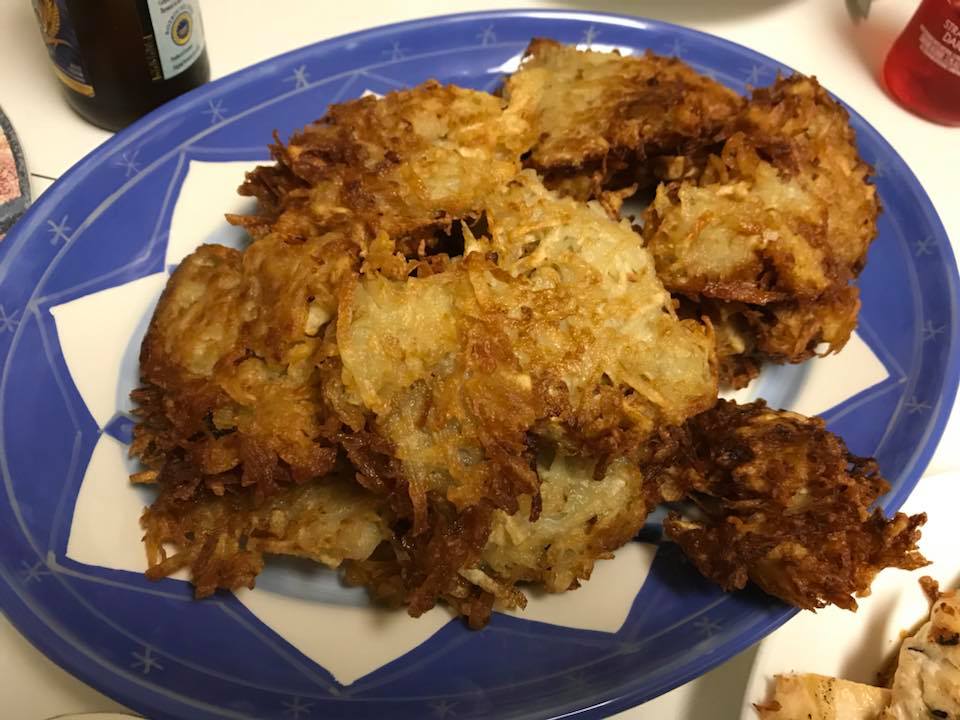 Article:
Article:
At the culinary heart of Hanukkah (which began at sundown Tuesday) are foods fried in oil to commemorate the triumph of the Maccabees, who won back their sacred temple, and the miracle of the oil that burned for eight days.
But there’s another Hanukkah story, not as well-known, that shifts the culinary narrative to a brave woman and her killer cheese. This story from the Book of Judith explains why dairy makes it onto the holiday table.
According to “The Interpreter’s Dictionary of the Bible,” the Assyrian leader Nebuchadnezzar sent one of his generals, Holofernes, to destroy the Jews of Bethulia, a town that commanded access to the road to Jerusalem. The plan was to seize the spring at the foot of the mountain, so the Jews would be deprived of their water supply.
When the cisterns in the town were empty, the people began to lose heart. It seemed better to live as slaves than to die in vain. One woman in town, a beautiful widow named Judith, had another plan.
She left Bethulia, dressed in festival garments to entice any man she might meet, and equipped with wine and food. The Assyrian guards — entranced by Judith’s looks — opened the gates of the city and escorted her up the hill to the enemy camp.
Pleased by her appearance, her beauty and her wit, Holofernes invited Judith to a banquet in his tent. When his officers left him alone with her, the general was so charmed by her that he ate the salty cheese cakes she had prepared, then quenched his thirst with her wine. More cheese cakes, much more wine. Until he fell drunkenly asleep.
And then, Judith pulled out his sword, and cut off his head.
She left the camp without arousing suspicion, her maid carrying the head in a bag. When the threatening army saw their general’s head, they panicked and fled.
Because Judith saved the Jews from a death order, many Jews honor her by eating cheese and dairy dishes: rugelach, blintzes, cheesecake, cheese latkes, even sour cream on potato latkes.
“We used to have a cake that was made out of cheese, like a fried-cheese-type thing,” says chef Laura Frankel, culinary director for Kosher Media International. Until the fried cheese tradition made it to northern and eastern Europe where they fried things in schmaltz (animal fat).
“Obviously, with kosher rules,” Frankel explained, “you can’t fry anything with cheese in schmaltz.” Mixing dairy and meat is banned in Jewish dietary laws. “So they changed the cheese out for potatoes. It was something people ate a lot of, they were filling, they were plentiful.”

This brings us to a shocking revelation. Though the original latkes were cheese latkes, the Ashkenazic Jews (who brought the latke to America) subbed potatoes.
And thus was born the latke that we all love today.
Judith’s Cheese Pastries
Adapted from “A Treasury of Jewish Holiday Baking” by Marcy Goldman, these pastries symbolize the cheese cakes that Judith served to Holofernes. Farmer cheese is a form of cottage cheese with most of the liquid pressed out, giving it a solid, crumbly texture. For best results, refrigerate the dough 8 hours or overnight.
Cheese Pastries

Adapted from “A Treasury of Jewish Holiday Baking” by Marcy Goldman, these pastries symbolize the cheese cakes that Judith served to Holofernes. Farmer cheese is a form of cottage cheese with most of the liquid pressed out, giving it a solid, crumbly texture. For best results, refrigerate the dough 8 hours or overnight.
- 2 1/2 cups flour
- 1/2 tsp salt
- 1/2 cup sugar
- 2 tsp baking powder
- 2 sticks (one cup) unsalter butter (cut into 16 pieces)
- 1 cup farmers cheese
- 2 tsp finely minced lemon zest
- 1 tsp fresh lemon juice
- 1 tsp vanilla extract
Filling
- 1/2 lb cream cheese
- 1/2 cup sugar
- 1 Tbsp flour
- 1 tsp finely minced lemon zest
- 1 egg
- 1/2 tsp vanilla extract
- 1 pinch of salt
Topping
- 4 Tbsp melted butter
- powdered sugar
-
For the dough: Sift the dry ingredients together in a large bowl; cut in the butter until the mixture resembles small crumbs. Blend in the farmer cheese to make a soft dough; then the lemon zest, lemon juice and vanilla. (For a food processor, pulse the dry ingredients together until combined. Add the butter; pulse until mixture resembles small crumbs. Add remaining ingredients; pulse until dough comes together. Knead on a lightly floured board to form a smooth ball.) Wrap the dough in plastic, and refrigerate overnight.
For the filling: Cream the cream cheese, farmer cheese and sugar together in a bowl until blended. Stir in remaining ingredients to make a thick filling. Refrigerate until ready to use.
Heat oven to 350 degrees. Line 2 baking sheets with parchment paper.
On a lightly floured surface, divide the chilled dough in half and roll each half into a 9-by-12-inch rectangle. Lightly brush each rectangle with 1 tablespoon melted butter.
Spread half of the cheese filling on each rectangle, leaving a 1-inch plain border all around. Fold in the 2 shorter ends on each rectangle. Beginning with the longer side, roll each piece into a log, but stop halfway. Cut off the remaining half of each piece and repeat, making another log. Each portion of dough will make 2 narrow logs.
Brush the tops of the 4 logs with the remaining 2 tablespoons melted butter. Chill, 10 to 15 minutes.
Remove logs from the fridge; cut them into 2-inch pastries. Place the pastries on the baking sheets. Bake until tops are golden brown, 25 to 30 minutes. Cool slightly, then dust with powdered sugar. Makes 24 to 30 pieces.
